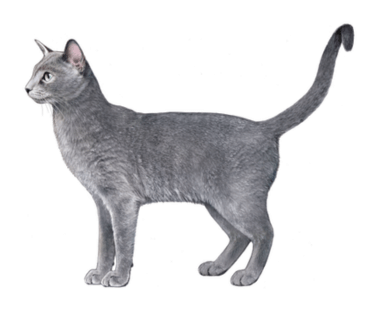Russian blue
About the Breed
Looking for a breed known as much for its brains as for its beauty? You may very well be looking for a Russian Blue. One of the cleverest of all cat breeds, these elegant silvery-grey shorthairs have emerald-green eyes that positively radiate with intelligence and charming faces that appear to be smiling at some secret joke. Easy to care for, easy to live with, Russians don’t need a lot of space to feel content, and while they may appear shy at first acquaintance, they quickly blossom into friendly, affectionate companions once they get to know you.
Breed History
Believed to have originated in the Archangel Isles in northern Russia, these cats have very little written history prior to the late 1800s. Russian folklore abounds with stories of these cats as good-luck charms and healing influencers, while other stories indicate they were the beloved pets of Russian royalty, not to mention two English queens. Thought to have been brought to England by sailors, Russians participated in the early English cat shows, but at the time they were called Archangel Cats and competed with all the other solid blue cats. From the early 20th century until World War II, Scandinavian breeders took the lead in developing the breed. After the war ended, U.S. breeders began importing cats from Europe and gradually combined the English and Scandinavian bloodlines to produce the Russian Blue we know today.
GENERAL
The good show specimen has good physical condition, is firm in muscle tone, and alert.
HEAD
Smooth, medium wedge, neither long and tapering nor short and massive. Muzzle is blunt, and part of the total wedge, without exaggerated pinch or whisker break. Top of skull long and flat in profile, gently descending to slightly above the eyes, and continuing at a slight downward angle in a straight line to the tip of the nose. No nose break or stop. Length of top-head should be greater than length of nose. The face is broad across the eyes due to wide eye-set and thick fur.
MUZZLE
Smooth, flowing wedge without prominent whisker pads or whisker pinches.
EARS
Rather large and wide at the base. Tips more pointed than rounded. The skin of the ears is thin and translucent, with little inside furnishing. The outside of the ear is scantily covered with short, very fine hair, with leather showing through. Set far apart, as much on the side as on the top of the head.
EYES
Set wide apart. Aperture rounded in shape.
NECK
Long and slender, but appearing short due to thick fur and high placement of shoulder blades.
NOSE
Medium in length.
CHIN
Perpendicular with the end of the nose and with level under-chin. Neither receding nor excessively massive.
BODY
Fine boned, long, firm, and muscular; lithe and graceful in outline and carriage without being tubular in appearance.
LEGS
Long and fine boned.
PAWS
Small, slightly rounded. Toes: five in front and four behind.
TAIL
Long, but in proportion to the body. Tapering from a moderately thick base.
COAT
Short, dense, fine, and plush. Double coat stands out from body due to density. It has a distinct soft and silky feel.
DISQUALIFY
Kinked or abnormal tail. Locket or button. Incorrect number of toes. Any color other than blue. Long coat.
COLOR: even bright blue throughout. Lighter shades of blue preferred. Guard hairs distinctly silver-tipped giving the cat a silvery sheen or lustrous appearance. A definite contrast should be noted between ground color and tipping. Free from tabby markings. Nose leather: slate grey. Paw pads: lavender pink or mauve. Eye color: vivid green.




